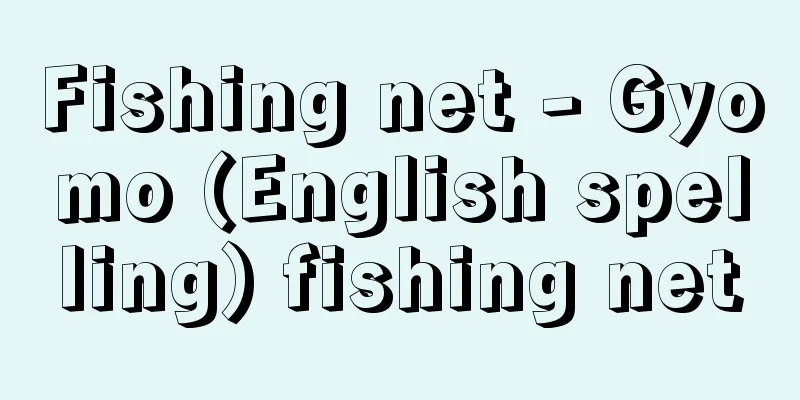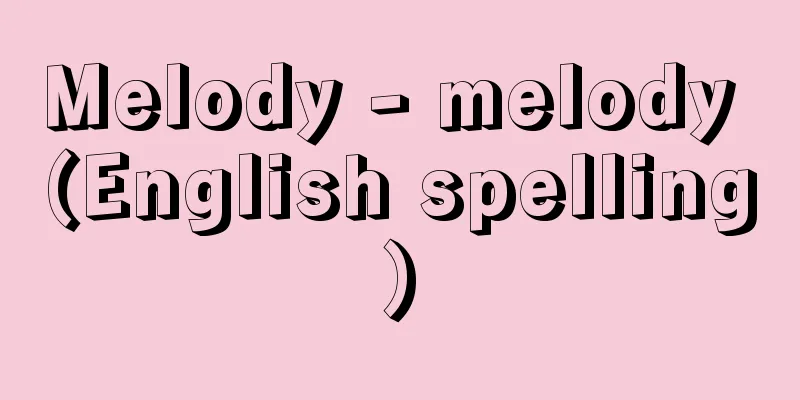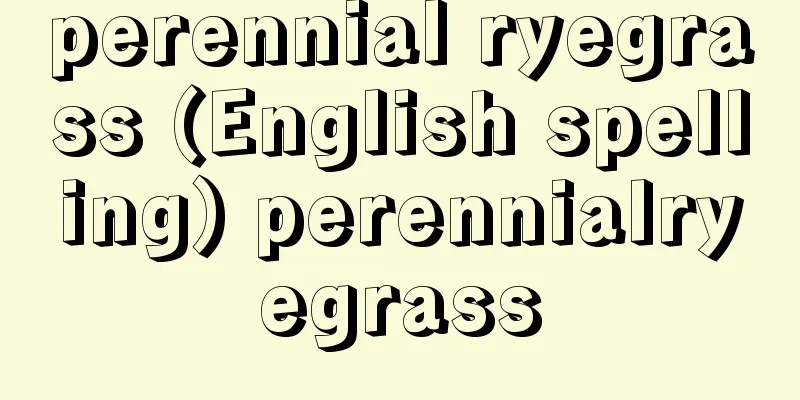Fishing net - Gyomo (English spelling) fishing net

|
In the narrow sense, it is a general term for net fabric used to capture aquatic organisms. In the broad sense, fishing nets encompass fishing net gear consisting of net fabric, ropes, floats, and sinkers. Fishing nets have different characteristics depending on the species of fish or fishing method to be caught, the type of fiber used, the weaving method, the mesh size, etc., and they are selected and used according to the purpose. Until just after World War II, natural plant fibers such as straw, palm, hemp, etc. were mainly used as materials for fishing nets. However, from the 1950s (1955-1964), various synthetic fibers were developed and rapidly spread due to their strength and corrosion resistance, and the performance of fishing nets improved greatly. The typical synthetic fibers currently used in fishing nets and their specific gravities are as follows: Saran (specific gravity 1.7), Krehalon (specific gravity 1.7), Cremona (specific gravity 1.3), Nylon (specific gravity 1.14), Hi-Zex (specific gravity 0.96), Pylen (specific gravity 0.91), and Seaking (specific gravity 1.45, a core of Saran covered with polyethylene film). For example, in large fixed nets, the fishing gear is constructed with consideration given to sinking and buoyancy by using heavy Cremona for the movement area (enclosure net part) and the bottom of the net, and lighter materials such as Hi-Zex sewn together for the surface layer. How to use fishing gear while considering the material characteristics is important for maintaining the net structure (the shape of the net underwater) in good condition in the fishing grounds. Fishing nets are broadly classified into knotted and knotless nets according to the weaving method. Knotted nets include frog-shaped knotted nets, double frog-shaped knotted nets, and honme knotted nets. However, honme knotted nets are often used for natural fibers, but are rarely used for synthetic fibers. Knotless nets include ordinary knotless nets, Russell nets, twisted nets, and woven nets. [Hideo Soeda and Kiyoshi Yoshihara] [Reference items] | | | |Source: Shogakukan Encyclopedia Nipponica About Encyclopedia Nipponica Information | Legend |
|
狭義には、水生生物を採捕するための網地の総称。広義には網地、綱類、浮子(あば)および沈子(ちんし)から構成された網漁具を包括して漁網という。漁網は、漁獲を目的とする魚種あるいは漁法によって、また素材となる繊維の種類、編網法、目合いの大きさなどによりそれぞれ特徴があり、目的に応じて選択され使い分けられる。網漁具の材料は、第二次世界大戦直後までは主として藁(わら)、ヤシ、シュロ、麻類などの天然植物繊維が用いられてきた。しかし、昭和30年代(1955~1964)から各種合成繊維が開発され、強靭で腐食しないことから急速に普及し、漁網の性能は大きく向上した。現在漁網として利用されている代表的な合成繊維とその比重を列挙すると、サラン(比重1.7)、クレハロン(比重1.7)、クレモナ(比重1.3)、ナイロン(比重1.14)、ハイゼックス(比重0.96)、パイレン(比重0.91)、さらにシーキング(比重1.45、サランを芯(しん)にしてポリエチレンフィルムで被覆したもの)など多種多様である。 たとえば大型定置網では、運動場(囲網(かこいあみ)部)や垣網の網裾(あみすそ)部に比重の重いクレモナを、表層の部分には軽いハイゼックスなどを縫い合わせて用い、沈降と浮力を配慮した漁具構成がなされている。漁具の材質特性を考慮した使い方は、漁場での網成り(水中での網の形状)を良好な状態に保つために重要なことである。 漁網は、その編網法によって有結節網と無結節網とに大別される。有結節網には蛙又(かえるまた)結節網と二重蛙又結節網、そして本目(ほんめ)結節網がある。ただし、本目結節網は天然繊維に多く使われるが、合成繊維ではほとんど用いられない。無結節網には普通無結節網、ラッセル網、捩子(もじ)網、織(おり)網などがある。 [添田秀男・吉原喜好] [参照項目] | | | |出典 小学館 日本大百科全書(ニッポニカ)日本大百科全書(ニッポニカ)について 情報 | 凡例 |
Recommend
African cane rat
Also known as the African bamboo mouse and the ree...
The Tales of Hoffmann - Les contes d'Hoffmann
An opera by French composer Offenbach. It has thr...
Silk screen printing - Silk screen insatsu (English spelling) silk-screen printing
A type of stencil printing. It is also called silk...
SRS-A (English) SRSA
…Of these antibodies, the immunoglobulin IgE anti...
Amzurek, P.
…Schreier and Kaufmann tried to connect it with K...
T-die extrusion
...The most common film produced by this method i...
Movie actor
〘 noun 〙 A person whose occupation is to appear in...
Object base
...Also, since the modern information processing ...
Harue Koga
An avant-garde Western-style painter from the lat...
actualisation
… The work of formalism was continued in the late...
Gulf of Alaska - Alaskawan (English spelling)
A bay formed by the wide intrusion of the Pacific ...
Genetic code
A code recorded as the sequence of nucleotides in...
Principle of Freedom of the Seas
…In order to be persuasive to sovereigns, theorie...
SAT - Science Fiction
Scholastic assessment test : A common test in the ...
Institutional school - Seido gakuha (English spelling) institutional school
A school of economics that was extremely influent...


![Hermit - inshuushi (English spelling) eremita [Latin]](/upload/images/67caf6301ad3d.webp)






